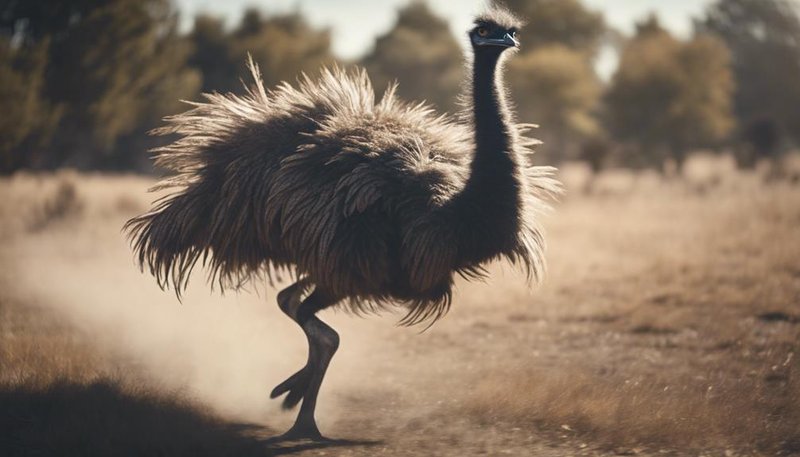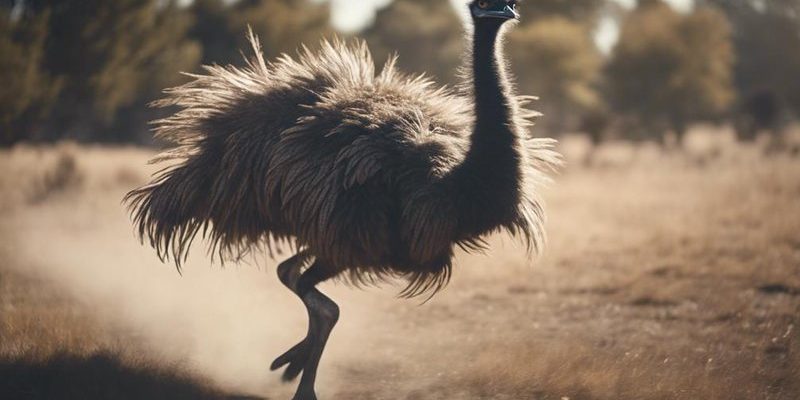
Here’s the thing: emus are often misunderstood. They’re not just the funny-looking birds that waddle around; they hold an important place in Australia’s wildlife ecosystem. If you’ve ever heard strange claims about emus, you’re not alone. Let’s dive into some of the most common myths and misconceptions about the emu, and help you understand the real facts about these interesting birds.
Myth 1: Emus Can’t Fly
You might be surprised to learn that, while it’s true emus can’t fly, they’re part of a fascinating group of birds called ratites. This group includes ostriches and kiwis, all of which have evolved to be land-dwelling. Imagine living in a world where flying overhead isn’t necessary; that’s the emu’s reality. With their powerful legs, they can run up to 30 miles per hour. So, while they may lack wings for flight, their speed more than makes up for it!
Interestingly, emus do have wings. They just happen to be much smaller compared to their bodies. Think of them as nature’s design for living close to the ground. Emus use their wings for balance while running and for courtship displays. So, instead of thinking of them as flightless, consider them as specialized runners, perfectly adapted for their environment.
Why Emus Don’t Fly
Many birds have wings as a key factor in their survival, helping them escape predators or find food. Emus, however, thrive in their Australian habitat without these advantages. They evolved to be ground foragers, feasting on a diet of grasses, seeds, and even insects. This diet makes them less reliant on flight for survival.
In ecosystems where predators are limited, being a flightless bird becomes a feature, not a flaw. It allows them to be super efficient at finding food on the ground, which is where they spend most of their time. So when you think of an emu, picture a master forager, not a bird that missed its flying lessons.
Myth 2: Emus Are Dangerous
When people spot an emu, many assume they’re aggressive or dangerous. However, this perception couldn’t be further from the truth. Emus are generally curious and timid creatures. They prefer to avoid confrontation. If they feel threatened, instead of charging, emus are more likely to run away.
That said, emus can protect themselves if necessary. If you corner them or threaten their young, you might see a different side. Like many animals, they’ll defend their territory when they feel it’s at risk. It’s important to respect their space, just like you would with any wild animal.
Understanding Emu Behavior
Emus have a unique personality. They’re often described as playful. They enjoy engaging with their environment, whether it’s running around or interacting with other birds. This sense of playfulness might be misinterpreted as aggression, especially if someone isn’t familiar with their behavior.
In a controlled environment, like farms, emus can be friendly and even playful with humans. People who raise them for their eggs or feathers often form bonds with these birds. So, instead of fearing them, think of emus as quirky companions in the animal kingdom!
Myth 3: Emus Are Only Found in Australia
It’s a common belief that emus are exclusive to Australia, and while they are native there, they’ve made appearances in other parts of the world too. In some countries, emus are raised for meat and eggs, leading to farms popping up outside their homeland.
For instance, you might find emu farms in the United States, where they’re raised for their lean meat and oil. These farms are helping to introduce more people to the emu, dispelling the notion that they only belong in Australia.
The Global Emu Presence
Outside of farming, emus have been seen in wildlife parks and zoos across various continents. This exposure helps educate people about their unique characteristics. So, while emus are undeniably iconic to Australia, their reach is spreading globally, thanks to conservation efforts and cultural exchanges.
In other countries, people are beginning to appreciate these birds’ unique qualities. As they learn more about emus, there’s a growing acceptance of their presence and importance in the ecosystem.
Myth 4: Emus Have No Significant Role in the Ecosystem
You might think emus are just amusing creatures that walk around, but they actually play a vital role in their ecosystems. As seed dispersers, emus help promote plant diversity. When they eat fruits and seeds, they travel long distances and deposit these seeds through their droppings. This action supports the growth of various plants, which in turn helps maintain a healthy environment.
By caring for the land, emus contribute to the balance of their ecosystem. Without them, certain plant species might struggle to thrive. So next time you see an emu, think of them as more than just a quirky bird—they’re essential workers in nature!
Emus and Plant Life
The relationship between emus and plants is continuous. They eat seeds from a wide variety of flora, including grasses and shrubs. Their habit of roaming allows them to cover large territories, spreading seeds over a considerable area. This behavior is crucial for the regeneration of many plant species, especially those found in Australia’s diverse environments.
In areas with fewer emus, you might notice a decline in specific plant populations. So, as you soak up the beauty of nature, remember to credit emus for their contributions. They’re not just amusing characters; they’re unsung heroes of their ecosystem.
Myth 5: Emu Oil Is Just a Trend
You might have heard about emu oil and how it’s become popular in skincare products. Some people think it’s just a passing trend, but let me explain why it has stood the test of time. Emu oil has been used for centuries, particularly by Indigenous Australians, known for its healing properties and anti-inflammatory effects.
Derived from the fat of emus, this oil contains several fatty acids that can be beneficial for the skin. It’s often used to help with conditions like eczema, arthritis, and inflammation. So, while it’s trendy, its roots trace back to practical, traditional uses that validate its effectiveness.
Why Emu Oil Works
The reason emu oil is effective lies in its composition. It’s rich in omega fatty acids, which can help moisturize the skin deeply without clogging pores. Plus, it has natural anti-inflammatory properties, making it appealing for various skin ailments.
Using emu oil might have a history of being a folk remedy, but its scientific backing continues to grow. Manufacturers are tapping into its potential, crafting products aimed at promoting skin health. It’s not just a fad; it’s a testament to the emu’s versatility.
So, there you have it! These common myths and misconceptions about emus don’t just blur the lines of reality; they also rob us of appreciating these unique birds. Emus are more than just flightless birds; they’re integral parts of their environment, playful creatures, and even valuable to human health.
Next time you hear a wild story about emus, remember the facts we’ve discussed. Whether they’re bustling through the Australian bush or making appearances worldwide, emus deserve to be seen for who they are: clever, curious, and crucial to our ecosystem. So let’s embrace these magnificent creatures and their many contributions to both nature and human life!

